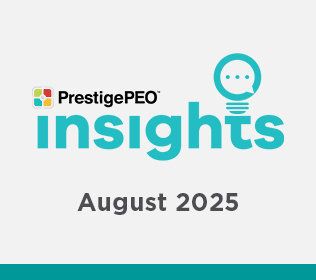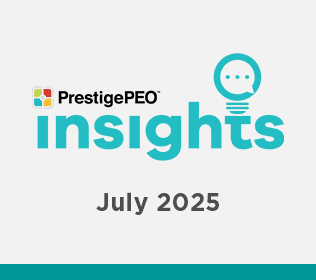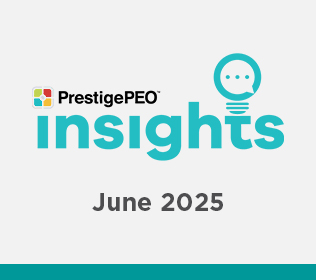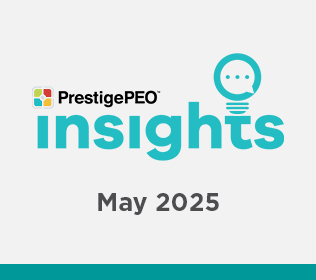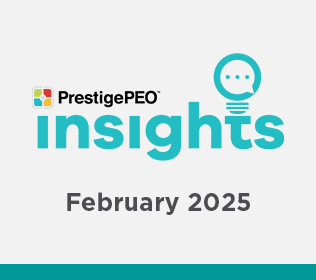
The latest news relevant to you and your business


Don’t Miss Out: Special Enrollment Ends Soon
PrestigePEO is offering a special open enrollment period for select voluntary benefits, but act fast – the special enrollment period ends on June 14! We have prepared a message you can copy and paste to share with your team members below.
PrestigePEO is offering a special open enrollment period for select voluntary benefits, but act fast – the special enrollment period ends on June 14! Explore benefits from MassMutual Whole Life Insurance, Aura Identity Theft Protection, Pet Insurance, Farmers Home & Auto, Monument Alcohol Counseling and Motivity Caregiving.
These benefits are normally only available for enrollment once a year during Open Enrollment, so take advantage of this special opportunity to enroll!
- MassMutual Whole Life Insurance: https://www.prestigepeo.com/wp-content/uploads/2023/10/MassMutual-Whole-LIfe-at-a-Glance_PrestigePEO.pdf
- Aura identity theft protection: https://www.prestigepeo.com/wp-content/uploads/2023/10/Identity-Fraud-Protection-Benefit-Booklet_Protection-Protection-Plus_Prestige.pdf
- Pet insurance: https://www.prestigepeo.com/wp-content/uploads/2023/10/MetLife-Pet-Insurance-Booklet_prestige-1.pdf
- Farmers home & auto: https://www.prestigepeo.com/wp-content/uploads/2024/04/Farmers_GroupSelect_Prestige-2024.pdf
- Monument alcohol counseling: https://app.joinmonument.com/patient/partner/intro?promocode=7EJ54
- Motivity caregiving: https://www.prestigepeo.com/wp-content/uploads/2024/01/Motivity-Care-Flyer.pdf
- MetLife webinar recording: https://www.prestigepeo.com/webinars/special-enrollment-metlife-2024/
- Register for a MassMutual webinar on May 30: https://prestigeemployee.webex.com/weblink/register/r67eed149150b5a0b9411a1eebc8d6bb8

Coming Soon: The Prestige Pulse for Your Employees
PrestigePEO sends out an informational newsletter entitled “The Pulse” to our client’s employees twice a year. This edition of The Pulse will contain helpful FAQs, an invitation to our upcoming MassMutual webinar, and more.
For a preview of the June Pulse newsletter, click the button below. Please select the “opt-out” button if you would prefer to remove your employees from this mailing list. The deadline to opt-out is May 30, 2024. The Pulse newsletter will be sent on June 13, 2024.

Hiring Tips: How to Choose the Best Candidate
Selecting the right candidate for your organization’s job openings is an integral part of ensuring an organization’s overall success. Taking the time to create a plan to support your hiring decisions can save you time and eliminate the frustration that is caused by the wrong hiring decision.
At the beginning of the process, think through the business case for the role and then establish job duties with the business requirements in mind. You can begin this process by meeting with internal stakeholders to discuss the reason for the position, how the role will fill the business needs, and the job responsibilities that best meet these needs. The stakeholders are those who understand the business and will work directly with the employee. They can provide insight into what the job entails. Stakeholders can include the direct manager, job incumbent, colleagues, or others who may interact with this employee. During this meeting, you can use an existing job description, if available, to help support the discussion. The job responsibilities may have changed since the last opening for the position, so it is important to review the job description and revise as necessary. Once the job description is finalized, it is time to consider your options for posting the role.
There are state and federal regulations that govern job postings. For example, in New York state, pay transparency rules will affect your posting, including the salary range for any position. Where you post the role is also significant as it may impact the quantity, quality, and diversity of candidates applying for the role. Ensure you take time to post the role where it will garner attention and qualified candidates. You can post on internal and external job boards, professional organization sites, and ask colleagues for referrals.
Applicant tracking tools such as JazzHR can help with posting job openings. Using these tools enables you to post the role on multiple job boards at once. (PrestigePEO offers JazzHR as an additional benefit – learn more about it here.) Tools like JazzHR also allows applicants to apply for positions via the ATS (Applicant Tracking System). These tools filter applications based on key words and even track communications between the employer and the applicant. Ultimately, using an applicant tracking system can help you improve your recruiting process and get to the best hire more efficiently.
Candidate Interviews
Before you begin to interview candidates, prepare the interview guide by creating relevant, job-related questions to give you a good understanding of the candidate’s skills, knowledge, and abilities. Ask a variety of behavioral based and situational questions, which help you to understand the candidate’s past job behaviors and gain insight into how the candidate may perform in the role for which they are applying. You may also include a series of more difficult questions to get a glimpse of how the candidate may respond to high pressure situations.
During the interview process, follow these simple tips:
- Give candidates an opportunity to answer all questions in your interview guide
- Take notes
- Ask others to interview candidates
- Evaluate candidates
- Make selections based on qualifications
Recruiting can be challenging, but your HRBP can support you with developing job descriptions, utilizing JazzHR for applicant tracking, and providing guidance during the process.

Update Regarding UnitedHealthcare
We have been informed that UnitedHealthcare experienced a data breach in February of 2024. UHC is aware of the concern this has caused and apologizes for the disruption to customers. They are committed to doing everything possible to help and provide support to anyone who may be concerned or impacted.
Given the ongoing nature and complexity of the data review, they will continue to analyze and identify impacted members. As the company continues to work with leading industry experts to analyze data involved in this cyberattack, it is immediately providing support and robust protections rather than waiting until the conclusion of the data review.
Members can visit a dedicated website at http://changecybersupport.com/ to get more information and details on these resources. A dedicated call center has been established to offer anyone impacted free credit monitoring and identity theft protections for two years. The call center will also include trained clinicians to provide support services.
The call center can be reached at 1-866-262-5342 and further details can be found on the website www.myuhc.com.

May is Mental Health Awareness Month
More than 1 in 5 US adults live with a mental illness. To recognize the importance of this month, we have prepared some helpful materials. Below, you’ll find a recent blog post on the importance of mental health benefits and two products that can support your team’s mental health. We hope these materials are helpful as you and your team recognize Mental Health Awareness Month.
The crisis and suicide hotline is 988. It provides 24/7, free, and confidential support for people in distress, prevention and crisis resources for you or your loved ones, and best practices for professionals in the United States.
Our Employee Assistance Program (EAP) provides access to counselors who can help you with various needs, including marital or family relationships, legal and financial problems, stress management, alcohol and substance abuse, crisis management, and more.
Monument is an online program that offers confidential alcohol counseling and treatment from the privacy of your home. It also includes virtual support groups, a community forum, and online tools.

Compliance Webinars
Over the past few months, PrestigePEO has conducted compliance webinars highlighting recent and upcoming laws and regulations impacting employers. We have an upcoming webinar on Wednesday, May 29, 2024, on the intersection of ADA and FMLA and practical steps to achieve compliance. Register for the webinar below.
Additionally, the federal government has recently released a final overtime rule and a final noncompete rule. If you missed this highly popular webinar, please tune in to the recording to hear the important highlights. We will be hosting follow-up sessions on this topic as the situation unfolds over the next few months!

Important Compliance Alerts
U.S. Department of Labor’s New Salary Thresholds Will Have Huge Workforce Impacts:
What Employers Need to Do Now to Be Ready
On April 23, 2024, the U.S. Department of Labor (DOL) finalized the new salary requirements for workers considered “white-collar” salary-exempt and highly compensated employees. These new thresholds are larger than initially proposed and are anticipated to impact about 4 million workers nationwide. Salary-exempt employees are workers that are otherwise exempt from the Fair Labor Standards Act’s minimum wage and overtime protections which require workers to be paid an overtime premium of 1.5 times their regular hourly rate of pay for all hours worked over 40 in a workweek.
The exemption from this overtime payment applies to workers employed in a bona fide administrative, executive, or professional (EAP) capacity, otherwise known as the “white-collar” exemptions, as well as the highly compensated employee (HCE) exemption. These earning thresholds do not apply to certain types of professional exempt employees, including doctors, lawyers, teachers, and outside sales employees, with few exceptions.
New Thresholds and Deadlines:
The DOL’s incrementally imposed new regulations will raise the salary threshold for workers classified as administrative, executive, and professional (EAP) exempt beginning on July 1, 2024, with another increase scheduled for January 1, 2025. The initial increased salary threshold will be raised to $844 a week ($43,888 annualized) no later than July 1, 2024, with the second increase to $1,128 ($58,656 annualized) by January 1, 2025.
The highly compensated employee exemption will also see an incremental increase, with the first one to $132,964 on July 1, 2024, and then to $151,164 on January 1, 2025. Thereafter, all salary-exempt classifications will automatically be updated and increase every three years beginning July 1, 2027, to reflect current earnings data and will be determined by applying to available data the methodology used to set the salary level in effect at the time of the update.
It is important for employers to remember that the salary threshold is just one aspect to be considered under the white-collar exemptions as per the FLSA overtime rules. Qualified employees must continue to meet the job duties test associated with each exemption classification, be paid on a salary basis, and be paid at least the designated minimum weekly salary. This may be an excellent time for employers to review the various salary classifications within their organization and make any necessary adjustments.
Furthermore, employers need to consider all applicable state laws as well. Many state and local regulations already require higher, stricter, or, in some cases, different wage and hour requirements to meet salaried-exempt status.
What to Do Now:
Employers need to plan and act quickly to ensure compliance with the increased, impending DOL thresholds. A first step is to identify which employees are considered exempt within your workforce that currently earn between $35,568 and the July 1, 2024 threshold of $43,888 a year for those in EAP positions. The evaluation will be slightly different for the Highly Compensated exempt employees. Next, consider whether to increase their salary to meet the new minimum threshold or whether the employee could be reclassified to another exemption such as outside sales. An additional alternative would be to consider converting them to non-exempt status.
Financial considerations regarding any transition to non-exempt status need to include an evaluation of how a new hourly rate, plus estimated overtime, may differ from a salary increase and the anticipated impact on your bottom line; how non-exempt employees’ work time will be tracked and maintained in compliance with DOL rules; impacts on benefits, including vacation, PTO, sick leave accruals, and other policies; and importantly, remaining mindful of the additional threshold increase in January 2025 to the $58,656 amount, which will have further financial consequences.
There are morale considerations for employers to navigate as well. While it may be impossible or impractical to raise every impacted employee’s salary to meet the new thresholds, implications of requiring formerly salaried employers, particularly those at the management level, to now accept a non-exempt position may be not only demoralizing but have a negative entity-wide impact. Being classified as a salaried-exempt employee can be a source of pride or respect among co-workers, and consideration should be given to overall morale and to management level employees who now will be expected to clock in next to their direct reports.
Finally, creating a communication plan that focuses on timely notice to employees regarding changes to their employment will be crucial for navigating these new DOL threshold requirements. Employees will need to fully understand the modifications to their wages and/or job duties, any new expectations surrounding timekeeping requirements, and other new or modified expectations. Additionally, many states and localities require formal Wage Notices to be provided to impacted employees, so it is important to consider these requirements in the communication plan as well.
PrestigePEO is here to help.
If you have any questions regarding these new DOL salary thresholds, please contact your HR Business Partner.
Senate Votes to Block NLRB Joint Employer Rule
On April 10, 2024, the U.S. Senate approved a measure to block the National Labor Relations Board’s (NLRB) joint employer rule, siding with business groups that argue it would be too costly in another blow to the rule after a federal court recently struck it down. A federal judge struck down the regulation in March after a coalition of business groups, including the U.S. Chamber of Commerce, challenged it in Texas federal court. This hot-button rule aimed to make it easier for workers to be considered employees of more than one entity for labor relations purposes.
As a reminder, under the NLRB rule, an entity would have been considered a joint employer of a group of employees if each entity has an employment relationship with the employees and they share or codetermine one or more of the employees’ essential terms and conditions of employment.
These terms and conditions of employment include:
(1) wages, benefits, and other compensation;
(2) hours of work and scheduling;
(3) the assignment of duties to be performed;
(4) the supervision of the performance of duties;
(5) work rules and directions governing the manner, means, and methods of the performance of duties and the grounds for discipline;
(6) the tenure of employment, including hiring and discharge; and
(7) working conditions related to the safety and health of employees.
Sen. Joe Manchin (D-W.Va.) and Independent Sens. Kyrsten Sinema (Ariz.) and Angus King (Maine) joined Republicans in rejecting the NLRB rule, which lowers the bar for finding that two companies must share obligations to negotiate with unions as well as joint liability for labor violations. The resolution blocking the rule, which passed in a 50-48 vote, now heads to President Joe Biden’s desk for an expected veto. Lawmakers, however, are unlikely to overcome Biden’s expected veto, given that the resolution cleared both chambers with less than a two-thirds majority.
PrestigePEO is here to help.
PrestigePEO is focused on supporting your business and will continue to monitor this new regulation and related litigation. If you have questions, please contact your HR Business Partner for assistance.
EEOC Releases Final Regulations for Pregnant Workers Fairness Act
On April 15, 2024, the U.S. Equal Employment Opportunity Commission (EEOC) issued its final rule implementing the Pregnant Workers Fairness Act (PWFA), which went into effect on June 27, 2023. The PWFA requires most employers with 15 or more employees to provide reasonable accommodations for an employee’s known limitations related to pregnancy, childbirth, or related medical conditions unless the accommodation will cause the employer undue hardship. The regulations have expanded the impact of this relatively simple and limited statute. According to the EEOC, the final rule and interpretative guidance “reflect the EEOC’s deliberation and response to the approximately 100,000 public comments received on the Notice of Proposed Rulemaking (NPRM)” after the NPRM was issued in August 2023.
In the accompanying press release, the EEOC also asserts that the final rule “provides clarity to employers and workers about who is covered, the types of limitations and medical conditions covered, how individuals can request reasonable accommodations and numerous concrete examples.”
Effective Date: June 18, 2024
Key Takeaways from the Final Regulation:
- The broad definition of “pregnancy, childbirth, or related medical conditions” includes abortion, infertility, use of contraception, and menstruation-related conditions. The EEOC refused suggestions to require a temporal proximity to pregnancy. However, it clarified in supplementary text that the condition had to be related to pregnancy or childbirth.
- The EEOC noted that nothing in the PWFA requires or forbids an employer-sponsored health plan to pay for or cover any particular item, procedure, or treatment, including an abortion. It is anticipated that the abortion aspect of the regulation will be the source of future litigation and will likely be tested in court.
- Specifies that the law applies to the pregnancy-related condition of the employee and does not create an accommodation obligation for a spouse, partner, or other family member to support a pregnancy, attempted pregnancy, or other condition.
- Even where an employee seeks unpredictable leave, the employer cannot rely on unpredictability alone to establish undue hardship. The employer would have to show that undue leave caused it significant difficulty or expense with respect to its business operations.
- Increased emphasis on lactation accommodations, including breaks to allow for direct nursing while the child is close by and refusing to categorically rule out remote work as an accommodation to improve lactation.
- Increased emphasis on providing interim accommodations, such as while awaiting documentation, assessing the viability of alternative accommodations in the interactive process, or as an outcome of an emergent situation.
- Employees unable to perform all essential functions for extended periods of time will continue to be regarded as “qualified” for their positions. The EEOC maintained its deviation from ADA caselaw in finding that an employee could be qualified for their position even if unable to perform all essential functions of the position for up to 40 weeks, related to pregnancy.
- Employers are severely restricted in seeking confirmatory documentation of the need or pregnancy-relatedness of a requested accommodation. The EEOC acknowledged that its approach under the PWFA was different and more restrictive than that allowed by the ADA. The EEOC added a statement that an employer could not even insist that an employee provide supporting documentation on its own form.
Job protection under the PWFA will cover workers who are not otherwise covered by employer-provided paid time off or federal, state, or local family leave laws. Employers are encouraged to remain responsive when an employee expresses the need for an accommodation and should also be careful to consider all state and local laws that may be related to this request. While employers do not have to grant the exact accommodation requested by an employee, they must offer the employee reasonable alternatives and be very cautious when denying a request altogether. As discussed above, proving an undue hardship to the operations or finances of an employer’s organization is a very high standard under the PWFA and will be more difficult than showing undue hardship under the ADA.
Due to the complexity of the PWFA regulations, employers are encouraged to reach out to their HR Business Partner with any questions or help in navigating this issue.
PrestigePEO is here to help.
PrestigePEO is focused on supporting your business. If you have questions or need assistance regarding the Pregnant Workers Fairness Act, please reach out to your HR Business Partner.
U.S. Supreme Court Holds That a Unilateral Job Transfer Maintaining the Same Pay and Benefits Could Be Discrimination Under Title VII
In Muldrow v. City of St. Louis, Missouri (Docket No. 22-193), the U.S. Supreme Court was asked to decide whether a unilateral job transfer, initiated by the employer without the employee’s request or consent, could be challenged as discrimination under Title VII, where the position had the same pay and title but changed the employee’s schedule, overtime opportunities, and other conditions of employment. In a unanimous decision, the Court held that an employee challenging a job transfer under Title VII must show that the transfer brought some harm with respect to an identifiable term or condition of employment, but the harm need not be significant.
In this case, the St. Louis Police Department transferred a female police sergeant from a position as a plainclothes officer in the Specialized Intelligence Division to a uniformed position elsewhere in the Department. While her rank and pay stayed the same, she no longer worked with high-ranking members of the Department, lost access to an unmarked take-home vehicle, and had a less regular work schedule that now included weekend shifts. She was replaced in the Specialized Intelligence Division by a male employee.
Sergeant Muldrow challenged the transfer under Title VII, alleging discrimination on the basis of sex. The District Court found for the City and dismissed her claim. The Court of Appeals agreed with the District Court, holding that the transfer “did not result in a diminution to her title, salary, or benefits” and had caused “only minor changes in work conditions.”
In reviewing the degree of harm that must be demonstrated, the Supreme Court indicated that the lower court’s requirement – that the claimant must demonstrate that the harm had to be “significant” – was too high a bar, and the word “significant” did not exist in the language of Title VII. “What the transferee does not have to show … is that the harm incurred was ‘significant,’ … [o]r serious, or substantial, or any similar adjective suggesting that the disadvantage to the employee must exceed a heightened bar,” Justice Elena Kagan wrote in the Court’s opinion.
This case is now sent back to the lower court to analyze the facts under the clarified standard and further to analyze that if such harm is demonstrated, the decision was in part based upon sex.
Important takeaways from the case:
- Providing transfers that maintain rank, salary, and benefits alone is not enough to avoid a claim of discrimination. A claimant need only show that some harm has occurred.
- Yet, demonstrating some harm is not the end of the case or the end of unilateral transfers. A claimant always maintains the ultimate burden that the transfer was based upon a protected employment category, such as sex.
- Before making unilateral transfers, fully analyze the impact and outline appropriate business reasons for the transfer. Communicate those business reasons to the transferee.
- Consider adding additional benefits for the transferee, if possible. Those benefits may not only avoid litigation, but might also change a reluctant, unhappy transferee into an appreciative, understanding employee.
PrestigePEO is here to help.
PrestigePEO is focused on supporting your business and will continue to monitor significant legal developments and court rulings. If you have questions, please contact your HR Business Partner for assistance.
FTC Issues Final Rule on Non-Compete Bans
On April 23, 2024, the Federal Trade Commission (FTC) voted 3-2 to issue a final rule that would ban virtually all non-compete agreements for nearly all workers of for-profit employers. The Rule is scheduled to be published on May 7, 2024, and will become effective 120 days after publication in the Federal Register, approximately September 4, 2024.
The crux of the Rule is that it makes noncompete clauses unlawful. The Rule states that it is an unfair and prohibited method of competition for a person to:
- enter into or attempt to enter into a noncompete clause,
- to enforce or attempt to enforce a noncompete clause,
- or to represent that a worker is subject to a noncompete clause.
What clauses are impacted by the Rule? The Rule defines a prohibited “non-compete clause” to include any contract term, workplace policy, or term or condition of employment, written or oral, that prohibits a worker from, penalizes a worker for, or functions to prevent a worker from seeking work, accepting work, or operating a business after prior employment ends.
The “functions to prevent” prong of the definition of the non-compete clause does not categorically prohibit other types of restrictive employment agreements, such as nondisclosure agreements (NDAs), client or customer non-solicitation agreements, or training-repayment agreements. However, if the NDAs or non-solicitation agreements are so broad or onerous that they have the same functional effect as a term or condition prohibiting or penalizing a worker from seeking or accepting other work or starting a business after their employment ends, such restrictive covenants will be viewed by the FTC as a non-compete clause under the Rule. In other words, confidentiality agreements, NDAs, non-solicitation of employees, and non-solicitation of customers will likely remain enforceable so long as they are not too broad. The Rule applies to non-compete clauses entered before the Effective Date.
Which employers and workers are impacted by the Rule? Generally, the Rule will impact all employers other than certain banks, savings and loan companies, non-profits, and common carriers, which are not subject to the FTC’s authority by law. The Rule defines “worker” very broadly and applies to paid and unpaid workers, including employees, independent contractors, externs, interns, volunteers, apprentices, and sole proprietors. The Rule does not apply to the franchisee in a franchisor relationship.
The exception for “Senior Executives”: the Rule provides an exception for non-compete clauses entered into with Senior Executives before the Effective Date. A Senior Executive means a worker receiving total annual compensation (excluding fringe benefits) of at least $151,164 in the preceding year and was “in a policy-making position”—meaning the entity’s president, CEO, officer, or other person who has final authority to make policy decisions that control significant aspects of the entity (and not just a subsidiary or affiliate).
The exception for “bona fide sales of business”: The Rule does not apply to non-compete clauses entered into “pursuant to a bona fide sale of a business entity, of the person’s ownership interest in a business entity, or of all or substantially all of a business entity’s operating assets.”
Notice requirements regarding existing non-compete agreements: Under the Rule, employers must provide “clear and conspicuous” written notice by the Effective Date to workers bound to an existing non-compete agreement who are not senior executives that the non-compete agreement will not be, and cannot legally be, enforced against them in the future. The notice can be delivered via various methods, including: (1) by hand to the worker, (2) by mail at the worker’s last known personal street address, (3) by email at an email address belonging to the worker, including the worker’s current work email address or last known personal email address, or (4) by text message at a mobile telephone number belonging to the worker. Employers may be exempt from the notice requirement with respect to the specific worker that they do not have any record of a street address, email address, or mobile telephone number. The Rule includes model language that employers can use to communicate with workers.
What happens to existing lawsuits? The Rule does not apply to causes of action related to non-compete clauses that have accrued prior to the Effective Date. Put another way, the Rule likely will not change cases involving alleged violations of non-compete clauses occurring before the Effective Date.
What do we expect next? Lawsuits challenging the Rule were filed within hours of the FTC’s vote, including one filed in the United States District Court for the Eastern District of Texas by the U.S. Chamber of Commerce. Given the rule’s expansive scope and impact, it is anticipated that at least some courts will enjoin it from taking effect until the U.S. Supreme Court has an opportunity to weigh in on its validity and constitutionality.
What should employers do now?
- Take inventory of existing non-compete clauses in your workforce and prepare (but do not yet issue) required notices.
- Review nondisclosure agreements and policies.
- Take advanced steps to protect trade secrets and confidential information.
- Update and refine your customer and employee non-solicitation provisions.
- Consider other alternative agreements.
Is there still risk when hiring a competitor’s employees? Yes. The Rule does not take effect for months and may never take effect if the court challenges are successful. The Rule also does not apply to conduct occurring before the Effective Date, so actions taken now still have risk. The Rule generally does not eliminate all risk to hiring employees from a competitor because even without non-compete clauses, employers can bring suit based on other contract terms (non-solicitation and non-disclosure clauses), trade secrets, and other legal theories to protect their interests when former employees go to work for a competitor.
PrestigePEO is here to help.
PrestigePEO is focused on supporting your business and will continue to monitor this new regulation and related litigation. If you have questions, please contact your HR Business Partner for assistance.
New York State Lawmakers Pass 2024-2025 Budget: Employers Need to Take Notice
On April 20, 2024, New York State lawmakers passed the 2024-2025 budget, which contains several provisions employers need to be aware of and start planning now for their workforce’s impact.
One of the new regulations requires that employers provide employees with twenty (20) hours of paid prenatal leave each year. This protected leave will allow employees to take leave either during pregnancy or for pregnancy-related medical appointments, procedures, tests, or other related appointments with healthcare providers. Important to understand is that this leave is separate from the already protected paid sick leave, which provides either 40 or 56 hours, depending on employer size, that is currently required by state law. Paid prenatal leave, similar to paid sick leave, may be taken in hourly increments, and the employee must receive their regular rate of pay when using this leave. This new leave law takes effect on January 1, 2025.
Additionally, New York State is requiring paid nursing leave for mothers who need break time to express breast milk during working hours. The current law allows for employees to take unpaid breaks during the workday at least every three hours or as reasonably requested by the employee, but starting June 19, 2024, employers will be required to provide paid thirty-minute breaks for this purpose. Furthermore, employees can utilize existing paid break time or mealtime, when necessary, for any period exceeding thirty minutes.
Finally, New York’s COVID-19 leave law is sunsetting as of July 31, 2025, which is a year longer than the initial proposal to repeal this law by July 2024. Employers will be required to continue to comply with COVID-19 leave laws, which currently require employers to provide employees up to fourteen (14) days of paid leave, separate from other leave accruals when the employee is subject to a mandatory or precautionary order of quarantine or isolation due to COVID-19.
PrestigePEO is here to help.
If you have any questions regarding these new requirements, please contact your HR Business Partner.
California DSLE Clarifies Paid Sick Leave as Applied to Part-Time Employees
The State of California Division of Labor Standards Enforcement (DSLE) has clarified how to properly apply the recently enacted Paid Sick Leave (PSL) rule changes as they pertain to part-time employees. This new legislation, which went into effect on January 1, 2024, requires specific time frames for employers to provide PSL to all employees, both part-time and full-time. These time frames are 24 hours (or 3 days) of PSL by the employee’s 120th day of employment and 40 hours (or 5 days) by their 200th day of employment, regardless of whether the employer was utilizing an accrual or frontload method.
The issue for California employers was that the legislation was unclear as to the applicability of these provisions to part-time employees, who otherwise would not meet these time frames under an accrual method. Generally speaking, these provisions required that an employee under an accrual plan must earn at least one hour of paid sick leave for each 30 hours of work, otherwise known as the 1:30 schedule. Part-time employees would not have earned the required minimum time off by the 120th and 200th day of employment because they would not have worked enough hours to accrue the PSL.
The California DSLE has now confirmed in the Frequently Asked Questions that employers are permitted to use the 1:30 PSL accrual structure or another method that may provide more generous sick leave accrual. If they do so, they will not be required to meet the benchmarks of 24 hours by the 120th day and 40 hours by the 200th day of employment, with few exceptions, for part-time employees.
More information on PSL questions can be found here.
What are the next steps for Employers?
Employers should update their employee handbooks to reflect the new clarifications for PSL accrual rule for Part-Time Employees.
PrestigePEO is here to help.
PrestigePEO is focused on supporting your business. If you have questions or need assistance regarding the California Paid Sick Leave for Part-Time Employees, please reach out to your HR Business Partner.
Navigating California's New Reproductive Loss Leave Law: A Comprehensive Compliance Guide for Employers
As of January 1, 2024, private employers in California with five or more employees and all public employers are required to provide leave for reproductive-related loss under the newly enacted California Senate Bill 848. This legislation expands bereavement leave rights, offering up to five days of unpaid protected leave following a reproductive loss event. In order to be eligible, the employee of a qualified employer must have been employed for at least 30 days prior to commencing leave and suffered a “reproductive loss event,” defined as “the day or for a multiple-day event, the final day” of any of the following:
- Failed adoption
- Failed surrogacy
- Unsuccessful assisted reproduction
- Miscarriage
- Stillbirth
Understanding the intricacies of this law is crucial for employers to ensure compliance and uphold the rights of their employees. This new law applies to any person who would have otherwise been a parent apart from the events listed above. These regulations mark a move towards acknowledging and accommodating the profound impact such experiences can have on individuals and families. Eligible employees may be entitled to multiple leaves per year, up to 20 days in a twelve-month period, and the leave must be taken, either consecutively or nonconsecutively, within three months of a reproductive loss. If prior to or immediately following the reproductive loss event, the employee exercises leave benefits under another state or federal leave entitlement, then the reproductive loss leave must be taken within three months after they complete their other protected leave.
All reproductive loss leave must be taken in accordance with the employer’s existing applicable leave policies. If no leave policies are applicable, this leave will be unpaid unless the employee chooses to use any accrued, available sick, personal, vacation, or other paid leave.
Here’s a comprehensive five-step guide to help navigate the complexities of California’s new reproductive loss leave law.
Step 1: Assess Your Existing Leave Policy: Begin by reviewing your current leave policy to determine its coverage of reproductive loss leave. Evaluate whether the policy extends to encompass this new category of leave and ascertain the extent of coverage provided. If your existing policy lacks provisions for reproductive loss leave, modifications may be necessary to ensure compliance with SB 848.
Step 2: Determine Paid Leave Entitlement: Evaluate the applicability of paid time off for reproductive loss leave within your organization. While the law does not mandate paid leave specifically for reproductive loss, existing accrued benefits such as vacation days, sick leave, or compensatory time off may be utilized during this period. Assess whether adjustments to your compensation policies are required to accommodate this new form of leave.
Step 3: Policy Update and Handbook Revision: Following a thorough review of your current policies, consider the amendments necessary to align with the requirements of SB 848. Update your company policies and employee handbook to explicitly include provisions for reproductive loss leave, outlining eligibility criteria, entitlements, and procedural guidelines. Ensure that all employees are informed of these updates to facilitate a seamless transition and foster transparency within the organization.
Step 4: Establish Confidentiality Protocols: Maintaining confidentiality is paramount when handling requests for reproductive loss leave. Designate a point of contact within your organization responsible for managing these sensitive matters and develop robust protocols to safeguard employee privacy. Ensure that any information disclosed regarding reproductive loss leave remains confidential and is only shared with authorized personnel on a need-to-know basis. The new law does not address whether employers may request medical or other related documentation as it pertains to an employee’s request for leave, but it does emphasize the need to maintain confidentiality. Establishing clear guidelines for confidentiality will help mitigate the risk of privacy breaches and uphold the trust of your workforce.
Step 5: Employee Education and Training: Educate employees involved in the leave request process on the intricacies of reproductive loss leave law and the obligations imposed by SB 848. Provide comprehensive training on best practices for handling leave requests, emphasizing the importance of empathy, confidentiality, and compliance with legal requirements. Equipping your staff with the knowledge and resources necessary to navigate reproductive loss leave will promote a supportive work environment and ensure that employees receive the assistance and understanding they deserve during challenging times.
California’s new leave rights for reproductive loss aim to make workplaces more supportive for people dealing with the challenges of pregnancy loss. As businesses adjust to this new provision, it is important to remain compliant with all other applicable leave laws as well.
PrestigePEO is here to help.
If you have any questions concerning your compliance with the new leave law, please contact your HR Business Partner for assistance.
New Florida Law Eases Work Restrictions for Older Teens: 5 Employer Considerations
In a move aimed at providing greater flexibility for young workers and their employers, the Florida Legislature recently approved a bill to ease existing work restrictions for minors aged 16 and 17. Governor DeSantis signed the bill, known as HB 49, into law on March 22, 2024, with the changes set to take effect on July 1, 2024. This significant shift in policy comes with a series of implications for employers and teenagers alike.
While both federal and state laws have historically placed limitations on the hours, types of work, and equipment that minors can use in employment, Florida has been one state with more stringent minor labor law regulations. However, with the passage of HB 49, the state is set to lighten the burden of restrictions, particularly for older teens.
Under the provisions of the new law, 16- and 17-year-olds will have the opportunity to work more than 30 hours per week during the school year, provided a waiver is submitted by a parent, guardian, or school superintendent to the employer. Additionally, while the law maintains restrictions that limit work to eight (8) hours in any one day between the hours of 6:30 am and 11 pm, teens in this age group will now be permitted to work more than eight (8) hours a day on holidays and Sundays during the school year, even when there is school the next day. Notably, homeschooled or virtual school attendees are also allowed to work during traditional school hours. The hourly restrictions will not apply to minors “employed by their parents” or those working “in domestic service in private homes.”
To ensure the well-being of young workers, the bill establishes mandatory 30-minute breaks for teens working more than eight (8) hours per day, to be taken every four (4) hours. However, it is crucial for employers to remain vigilant, as violations of these regulations can result in substantial civil fines and, in some cases, criminal penalties.
With these changes on the horizon, employers need to consider several key questions when hiring teenagers:
- Applicant Pool: Will the relaxation of work restrictions attract a larger pool of teenage applicants? Understanding local youth employment trends and demands can help gauge the impact of widening the net.
- Managerial Training: Are managers adequately trained to navigate and comply with the regulations governing youth employment? Proper training is essential to ensure adherence to the law and maintain a safe working environment for young employees.
- Age Requirements: Will you set a minimum age requirement for hired minors? Given the less restrictive nature of rules for 16- and 17-year-olds, employers may have more flexibility in hiring older youth.
- Hazardous Occupations: Are the jobs being offered considered hazardous occupations under federal or state law? It’s crucial to be aware of and comply with restrictions on certain types of work deemed unsafe for minors.
- Timekeeping Systems: Does your timekeeping system have automated safeguards to prevent minors from working during prohibited hours or exceeding allowable hours? Utilizing properly programmed and maintained timekeeping systems can help eliminate human errors and ensure compliance with regulations.
While HB 49 represents a relaxation of work restrictions for minors, employers in Florida must remain diligent in upholding compliance with child labor laws. This includes regular reviews of hiring and employment practices, comprehensive training for managers, and internal audits to ensure alignment with both state and federal regulations governing youth employment. By prioritizing legal compliance and the well-being of young workers, employers can navigate these changes effectively and contribute to a positive working environment for teenagers entering the workforce.
PrestigePEO is here to help.
If you have any questions concerning your compliance with the new Florida minor labor law regulations, please contact your HR Business Partner.
Navigating Florida’s New Workplace Regulations: What Employers Need to Know
Florida’s business landscape is undergoing significant changes with the recent enactment of House Bill 433, signed into law by Governor Ron DeSantis on April 11, 2024, which usurps authority from local governments, leaving the governing process related to various employment regulations solely in the discretion of the state legislature. This legislation reshapes the regulatory framework for workplaces across the state, particularly in three key areas: heat safety protocols, wages and benefits, and scheduling practices. Here are the top three takeaways for employers as they adapt to these new requirements.
Heat Safety Protocols: Ensuring Compliance with Federal Standards
One significant aspect of HB 433 is its impact on heat safety protocols in the workplace. With Florida operating under federal Occupational Safety and Health Administration (OSHA) jurisdiction, the new law preempts local governments from imposing additional requirements beyond those mandated by federal regulations. This means that employers must align their heat safety practices with the standards set forth by the OSH Act. To mitigate the risks associated with extreme heat exposure, employers are encouraged to conduct thorough hazard analyses, develop comprehensive heat illness prevention programs, and provide necessary resources such as access to cold water, shaded areas, and cooling fans. Additionally, designated employees should be tasked with monitoring working conditions and ensuring prompt medical attention for any signs of heat-related illnesses. Compliance with these guidelines is essential for creating a safe and healthy work environment, particularly as the provisions of HB 433 come into effect on July 1.
Wages and Employee Benefits: Implications for Local Contracting Power
HB 433 also introduces significant changes regarding local governments’ authority to regulate wages and employment benefits through their contracting power. The law prohibits municipalities from influencing private employer wage rates and benefits by awarding preferences to entities offering more favorable compensation packages. Moreover, it restricts the ability of local jurisdictions to enforce minimum wage requirements or mandate additional benefits beyond state and federal obligations. This provision has far-reaching implications, particularly for counties like Broward and Miami-Dade, which have previously implemented living wage ordinances. As a result, employers contracting with these municipalities will need to reassess their wage and benefit structures to ensure compliance with state and federal laws. The effective date for these revisions, impacting contracts entered after September 29, 2026, underscores the importance of proactive adjustments to business practices.
Scheduling and Predictive Scheduling: Legislative Oversight
Finally, HB 433 addresses the issue of scheduling practices, specifically predictive scheduling, which has gained traction in various jurisdictions across the country. Predictive scheduling laws typically require employers to provide advance notice of work schedules and may include provisions for penalty pay or employee input on scheduling. In Florida, the new legislation shifts the authority to regulate scheduling policies from local governments to the state legislature and governor. Any predictive scheduling requirements will now require legislative approval, emphasizing the state’s role in determining workforce regulations. This centralized approach aims to provide consistency and clarity for employers while streamlining regulatory processes.
As employers navigate the implications of HB 433, proactive measures are essential to ensure compliance with evolving workplace regulations. By understanding the implications of these changes and taking proactive steps to adjust policies and practices accordingly, businesses can mitigate risks and foster a productive and compliant work environment in Florida’s evolving regulatory landscape.
PrestigePEO is here to help.
If you have any questions concerning any regulation, please contact your HR Business Partner.
New Laws passed for Washington State in 2024
Governor Jay Inslee of Washington State had recently passed several bills into law. The new laws will become effective starting on June 6, 2024.
Restrictive Covenants
Governor Inslee signed Substitute Senate Bill (S.S.B.) 5935 regarding restrictive covenants into law on March 13, 2024, and it will go into effect on June 6, 2024. The provisions of the new substitute bill will clarify and update the Washington law regulating restrictive covenants. The law clarifies that employers must disclose non-competition covenants to prospective employees no later than the time of the initial acceptance letter. The new provisions will also limit non -solicitation agreements to current employees. Additionally, the amendment will clarify the sale of business exception by limiting the statute’s exemption for non-competition covenants “only if the person signing the covenant purchases, sells, acquires, or disposes of an interest representing one percent or more of the business.”
Ban on Mandatory Employer Meetings
Governor Inslee signed the Ban on Mandatory Employer Meetings bill into law on March 28, 2024, and it will go into effect on June 6, 2024. This new law will “prohibit an employer from taking adverse action against an employee for refusal to attend or participate in an employer-sponsored meeting or refusal to listen to speech, the primary purpose of which is to communicate the employer’s opinion concerning religious or political matters.”
Safeguards for WPFML-Related Healthcare Information
Governor Inslee signed Safeguards for WPFML- Related Healthcare Information into law on March 18, 2024, and it will go into effect on June 6, 2024. This new law will make sure healthcare providers provide certification of a serious health condition required for benefits eligibility under the Paid Family and Medical Leave (PFML) Program within seven (7) calendar days of receiving patient authorization. The law will also prohibit healthcare providers and healthcare facilities from charging a fee for a certification of a serious health condition in connection with applications for PFML benefits.
Data Collection with Respect to H-2A Workers
Governor Inslee signed the bill regarding Data Collection with Respect to H-2A Workers into law on March 25, 2024, and it will become effective on June 6, 2024. This new law will require the Employment Security Department (ESD) to obtain certain information related to temporary foreign workers who are lawfully present in the United States to perform agricultural labor, who are also known as H-2A workers. The ESD will have to gather accurate worker counts when conducting field checks and field visits. The law will additionally require the ESD to conduct annual wage surveys of non-H-2A workers who primarily work by hand harvesting apples, cherries, pears, and blueberries.
Expanded Protections Under the Equal Pay and Opportunities Act
The Expanded Protections Under the Equal Pay and Opportunities Act was signed into law on March 28, 2024, but will not go into effect until July 1, 2025. This new law will be an addition to the Washington Equal Pay and Opportunities Act (EPOA) and will include all protected classes. The new EPOA amendments will now prohibit pay discrimination based on membership in protected classes. The protected classes under the law are defined as “person’s age, sex, marital status, sexual orientation, race, creed, color, national origin, citizenship or immigration status, honorably discharged veteran or military status, or the presence of any sensory, mental, or physical disability or the use of a trained dog guide or service animal by a person with a disability.”
PrestigePEO is here to help.
If you have questions, please contact your HR Business Partner for assistance.
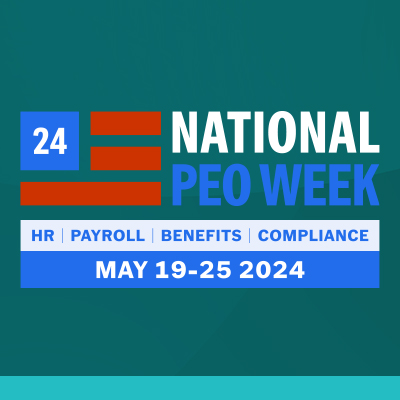
Celebrating National PEO Week!
PrestigePEO is excited to celebrate National PEO Week, which takes place from May 19-25! We will be attending NAPEO’s Capitol Summit in Washington, D.C. This event will allow leading PEOs like ours to meet with lawmakers and educate them on the critical role that PEOs play in supporting businesses across the country. PrestigePEO is always proud to offer competitive employee benefits, efficient administrative support, and helpful HR resources. We will continue to make strides and grow our clients’ businesses to new heights.
If you feel your PrestigePEO partnership has been beneficial, we’d love to hear from you. Click the link below to leave us a Google review or refer a business colleague.

Protect Your Pets with Pet Insurance
You love your pets, and healthy pets are happy pets. That’s why we’re proud to offer MetLife Pet Insurance. Veterinary expenses can accumulate rapidly, making pet insurance plans a valuable solution. With MetLife Pet Insurance, you may be able to receive reimbursement for up to 100% of covered veterinary care expenses.

Offer Your Employees Security Protection with Aura
Aura provides all-in-one protection from online threats for the whole family. This service works across multiple devices to safeguard your information. With MetLife Aura, you can enroll in a robust digital security plan to help protect you and your family from financial and identity fraud. Aura is available now during our special enrollment period, but sign up before June 14! Click the button below for more information, and reach out to your Benefits Specialist to learn more.
Feedback
If you have an idea for a future newsletter, we’d love to hear from you! Additionally, if you’d like more information on our services or programs, we can certainly accommodate that as well. Email marketingteam@prestigepeo.com today!
